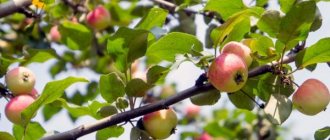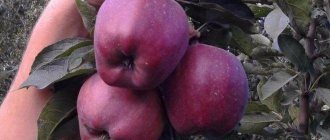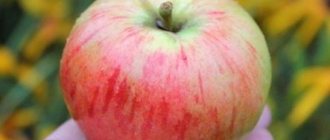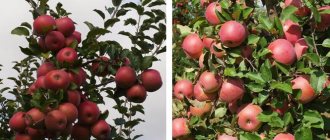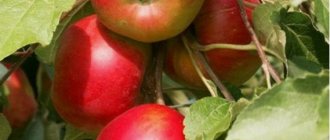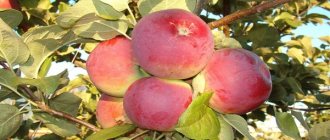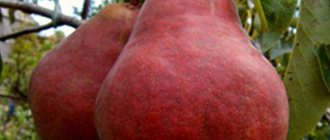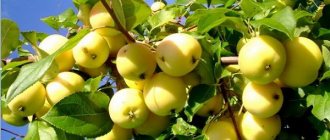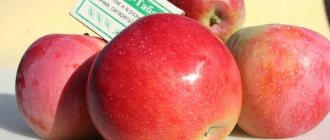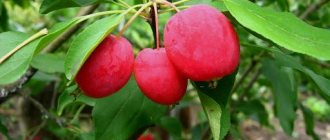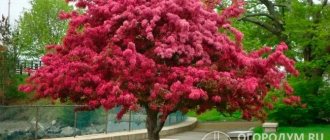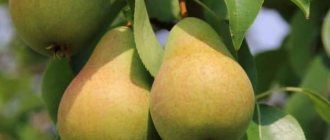Apples are one of the most common fruits in the world. People use them almost every day. But most people buy apples in stores.
And if you grow these fruits in a garden or personal plot, the fruits will be much more useful. But in order to do this, you must first plant an apple tree, and before that you also need to choose the appropriate type of tree.
Today, choosing a variety is a rather serious task. To avoid mistakes in this matter, it is necessary to take into account many important factors.
It is important to choose zoned varieties. These are the varieties that will perform well and produce a good harvest in your region.
In this case, it is necessary to take into account whether the variety has good winter hardiness and what level of resistance against diseases and pests.
The yield of the variety, the size and taste of the fruit, as well as the purpose of the variety are also of great importance Most varieties, of course, are universal, but there are also those that are better suited, for example, for making juices or jams.
So the choice of variety is one of the first indicators that is necessary for planting an apple tree. And in order to avoid mistakes, you need to read information about the variety, or consult with specialists.
Photo and description of the variety
The apple tree of the Gin variety is columnar. The height of such a tree is small. The maximum height reaches two meters.
The tree has only one trunk without large and spreading branches and shoots. This allows you to place the apple trees closer to each other.
With this arrangement, you can plant up to a dozen apple trees of different varieties. The planting pattern for columnar apple trees will be approximately 70 by 80 centimeters (70 cm is the distance between apple trees, 80 cm is the distance between rows) .
The Gin variety is considered a fast-bearing tree:
- Fruiting begins already in the first and second years after planting;
- The first three to four years, the yield of the apple tree is small and ranges from four to five kilograms;
- But after the fifth year of fruiting, the yield increases noticeably.
From one tree you can collect from 12 to 15 kilograms of delicious fruits.
The fruit size is medium, spherical in shape. The color of the apples is bright red. The appearance and taste of the fruit resembles the famous Melba apple variety. The pulp is juicy, dense, with a sweet and sour taste.
The Gin apple tree is considered a winter tree. Fruit ripening begins in September. Fruit storage occurs over a long period. If stored properly, they can be stored for up to 6 months. At the same time, they practically do not lose their taste.
The tree is resistant to diseases such as scab.
Winter hardiness is good. Important! With proper shelter, it performs well when grown in central Russia and the Urals.
Columnar apple tree Jean.
Advantages and disadvantages
The variety is universal. With minimal maintenance costs, gardeners receive great benefits - apples are stored for a long time, do not spoil and are successfully transported over long distances.
Description of the positive characteristics of Gin:
- the crop is grown in central Russia;
- withstands sudden cold snaps, and only the upper part of the rhizome freezes, which quickly recovers in the spring;
- good resistance of the variety to powdery mildew.
Resistance to scab allows you to obtain a stable annual harvest.
Even during epidemics, culture does not suffer. It is rarely attacked by pests - in this case it will be necessary to install special nets. And it does not suffer from powdery mildew, so with proper care, the fruits do not become deformed.
The only disadvantage is the poor survival rate of the crop on frequently blown land plots.
additional characteristics
Advantages and disadvantages
One of the most important advantages of the Gin Tree is its high winter hardiness . The apple tree feels good without problems in central Russia, as well as in the Urals.
An advantage is the high level of resistance against diseases. The tree is resistant to the common scab disease. Gin is considered one of the popular varieties among gardeners.
Attention! The Gin variety is a very good apple tree. It has no major drawbacks.
Dimensions of an adult tree
The average tree size varies from 1.5 to 2 meters. The maximum height sometimes exceeds 2 meters. This will depend on the growing conditions and the variety.
Annual growth
In columnar apple trees, the annual growth is small. Since the height of the tree usually does not exceed two meters. The annual growth is approximately 15 - 20 centimeters. The columnar apple tree reaches 18–20 centimeters in width, since the fruits form and ripen on the ringlets.
One-year-old apple tree seedling.
Frequency of fruiting
The first harvest of several apples can be obtained in the first year. A more abundant harvest occurs after the fifth year after planting. After this period, the apple tree bears fruit every year.
In some years, apple trees enter a dormant period. This period is necessary to restore the vitality of the tree. At this point, only a few fruits can be obtained from the tree.
However, there are times when the apple tree does not bear fruit at all. This is primarily due to the tree being infected with some disease or severe damage by pests. In rare cases, this situation arises due to unfavorable climatic conditions.
Productivity
The mass of apple fruits of this variety ranges from 120 to 200 grams. But since the height of the tree does not exceed two meters, the yield is low. The average yield is from 15 to 20 kilograms.
Tasting assessment
Apples are very juicy and tasty. The tasting score of the fruit is 4.7 points.
You can make very tasty jam from the fruits. Freshly squeezed juice is very tasty.
Apples are also consumed fresh; in this form they bring maximum benefits and saturate the human body with essential vitamins.
Winter hardiness
Columnar Gin has fairly high winter hardiness . Tolerates winters well with long periods of low temperatures.
It also does not suffer much from winter and spring nighttime temperature changes. If the climatic zone in which the apple tree grows is too harsh, then the tree trunk can be wrapped with a special covering material.
With proper shelter, the apple tree is not in danger. And since the height of the tree is small, most of it will be under snow cover. This way you can get rid of problems with frost.
Disease resistance
The tree has high disease resistance . The apple tree is practically not damaged by diseases and pests even during mass epidemics. In addition, it is resistant to diseases such as scab. This refers to the advantages of the variety.
The Jean apple tree is resistant to scab.
Characteristics
- One of the qualities that attracts a gardener to this apple tree is its early fruitfulness. The variety is capable of producing a good harvest already in the 2nd year after planting;
- our hero blooms at the end of May, when return frosts no longer pose a serious threat;
- According to the ripening period, the variety is classified as autumn. The harvest begins to ripen at the end of August;
- The productivity of the columnar crop is impressive. In the first 3 - 4 years, the yield will be 4 - 5 kg. But after 5 years, this figure increases significantly and is about 15 kg per tree. During the period when ripe fruits are ready to be picked, the graceful tree looks very attractive; perhaps, a better decoration for the garden cannot be imagined;
- ripened apples do not fall off, so you can take them off the tree slowly;
- but such decorativeness and productivity do not last long; the productive life of a columnar apple tree is shorter than that of an ordinary one. At best, it will last 12 - 15 years, and in cold regions even less;
- Jin's immunity is quite strong. First of all, gardeners are pleased to note the good resistance to scab, due to which the appearance of apples remains attractive;
- good winter hardiness is also noted. There are no specific data, but when compared with the Iksha variety, our hero is somewhat inferior in this indicator. But in the conditions of the Central region of Russia, the plant tolerates winters calmly;
- It should be noted that the apples have a good keeping quality. High-quality fruits can withstand almost six months of storage (until February), without losing either their attractiveness or taste;
- method of use is universal. Apples are good in their natural form due to their dessert taste. If desired, the harvest can be successfully processed into jam, jam, compote, juice.
Reviews
Valentina. “Apple Gin is one of the popular varieties. There are 2 trees growing on my site. The neighbors also have several of these trees. The variety is very good. Winter hardiness at a high level. It has been growing here for 5 years now. No frost damage was observed during the entire period. The tree also has resistance against diseases. There is immunity to scab damage. And the most important thing is the size and taste of the fruit. Apples are very tasty and juicy. The color is bright red. The mass of apples reaches 200 grams. Another advantage is the long shelf life of apples. They can be stored for up to 6 months."
Novel. “The Gin apple tree has proven itself well on my site. The tree is columnar. The layout is small. The distance between neighboring apple trees is 70 centimeters, and between rows is 80 centimeters. Thus, you can increase the number of trees on your site, as well as diversify apple trees with different varieties. The yield for a tree with this type of structure is good, up to 20 kilograms per tree. The apples are large and sweet. I recommend to everyone!"
Olga. “Gin is a very good variety. Has very good winter hardiness. It can withstand almost any frost, provided that the apple tree is properly covered and covered with snow. The apple tree is disease resistant. Well suited for fresh consumption and for making jam, jam and freshly squeezed juice. Children especially love it. Be sure to plant this variety in your area.”
Vadim. “I really like this variety because of the large size of the fruits. The apples are very beautiful. At the same time they have excellent taste. The pulp is juicy. The fruits are well suited for making freshly squeezed juice. Gin is easy to care for. The size of the tree is small. This makes it easier to care for the tree, as well as harvest it.”
Characteristics of the variety
Apple trees of this species are characterized by normal winter hardiness and tolerance of long cold periods and daily temperature changes. The tree grows best in warm climates, but with proper shelter and sufficient snow cover it can successfully develop and bear fruit in colder regions (for example, in the Urals).
The Gin apple tree is characterized by early ripening of the crop in September, however, it largely depends on climatic conditions, for example, early or late spring.
This variety of apple tree is columnar: on a single dwarf-sized trunk (no higher than two meters) there are several side branches that grow at an acute upward angle, so the crown of the tree is very reminiscent of a young cypress. Every year the height of the tree increases by 0.15-0.2 meters, the width of the trunk is a maximum of 0.2 meters in diameter. A lot of lateral ringlets (small shoots) are formed.
The inside of the trunk is very dense, because a small tree has to withstand quite a significant weight of ripe apples - about 10-12 kilograms. In general, Jean's yield ranges from 35 to 45 kilograms per apple tree. It begins to bear fruit from the second year after planting a seedling: a one-year-old can produce the first 4-5 kilograms of apples, an adult tree is much more productive than ordinary apple trees.
The foliage is of the usual shape characteristic of this fruit, dark green in color. The apple tree usually blooms at the end of May, with very beautiful small white flowers, almost all of which form ovaries for future fruits. This variety of columnar apple tree is self-fertile, however, if there is a pollinator in the form of other apple trees or insects (bees, butterflies), the yield will be higher and the fruits will be larger.
The tree bears fruit with medium-sized spherical apples covered with glossy thin skin. Each ripe apple is colored bright red or crimson with specks; unripe fruits are green.
Additional Information. Externally, Gin resembles Melba apples. The pulp of the fruit is cream-colored, tastes sweet without an acidic taste, slightly fresh, dense, with a lot of juice.
Universal use: in raw form (according to tasters, Gin apples deserve 4.7 points), and also for making:
- freshly squeezed juice and compotes;
- jam, jam, deep-frying;
- jam;
- drying and drying;
- baking and decorating dishes;
- alcoholic drinks and cider.
Ripe fruits do not fall from the tree, but wait until harvest. They are stored in a dark place at the required temperatures for about six months, and they can also be transported over long distances.
The apple orchard of this variety is resistant to scab and other diseases, even with massive damage to neighboring fruit trees.
Features of planting and care
Landing
Deadlines
The optimal time for planting an apple tree is the end of April and until the beginning of May. Planting must be done before the sap begins to flow in the shoots and branches of the tree. And also before the buds open.
Planting can also be done in the autumn. It is better to do this before the end of September. You need to look at the weather. If you don’t do it in time, the shoots may not have time to ripen and then the apple tree may freeze a little.
Therefore, spring planting is considered safer.
Important! If planted correctly, the seedling will not feel mechanical stress and will easily survive transplantation.
Technology
In order for the apple tree to take root well, it is necessary to plant correctly:
- First you need to dig a hole from 80 centimeters to one meter deep. The depth will depend on the size of the root system;
- An iron stake is dug into the center of the hole, to which the seedling is fixed;
- They also make a small mound of soil in the center, on which the root system expands;
- After this, you need to cover the seedling with soil and water it well;
- After the soil has settled, you need to add more soil and water again;
- Also mulch the tree trunk of the seedling to preserve soil moisture.
Apple tree planting diagram.
Distance
Since the apple tree is columnar, the distance between the apple trees is small. Optimal planting pattern: 70 cm between apple trees and 80 cm between rows.
Agricultural technology and cultivation
Agricultural technology should include:
- Landing;
- Watering;
- Feeding;
- Formation and pruning of the crown.
Watering should be moisture-recharging. Water 3-4 times per season , depending on weather conditions.
It is better to feed with complex fertilizers also 3-4 times during the growing season.
It is important to carry out timely pruning and the necessary formation of the crown.
The peculiarities of growing columnar apple trees include a very good planting scheme.
A small distance between the trees allows you to create a hedge on which tasty and healthy fruits will ripen.
Pruning and crown formation
The columnar apple tree Jin has only one trunk and short ringed branches. There is no need to create such a tree. It is necessary to carry out sanitary pruning. Remove dried, diseased branches and damaged shoots.
Pollinator varieties
The variety is largely self-fertile. But when pollinated by insects and other varieties, it increases the yield and quality of the fruit. The size and taste of the fruit may increase.
Landing technique
If spring planting of seedlings is planned, then the plot is harvested in the fall. A bucket of compost (humus), 1 kg of wood ash and 50 g of phosphorus and potassium are added to the plot (per m²).
There is a certain technology for planting this crop, which ensures its successful rooting and further fruiting:
- First, planting holes are dug according to the size of the root system - approximately 80x80 cm.
- The optimal planting pattern is 70 cm between seedlings and 80 cm between rows.
- A wooden or metal stake is driven into the center of the hole, which in the future will serve as a support for the seedling and protect it from the wind.
- A mound of garden soil is made in the center, and the straightened roots are laid on top of it.
- The roots are sprinkled with garden soil and compacted well to prevent voids from forming. The planted tree is watered abundantly with warm, settled water - 2 buckets per specimen.
- After the soil shrinks (after 2-3 days), it is necessary to add more soil and water the seedling again.
- To prevent moisture evaporation, the tree trunk area is mulched with rotted manure or garden soil.
When planting, it is important to prevent the root collar from sinking, which can cause rotting of the tree trunk area and the death of the seedling.
Features of ripening and fruiting
Fruiting
Start
Columnar apple trees are distinguished by their early fruiting period. The first fruits can already be obtained in the year the seedling is planted. The tree will produce an average harvest from the second and third years of life. In the fifth year, the tree will already produce a stable harvest.
The first fruits can be obtained in the year of planting.
Peculiarities
A feature of the fruiting of this apple tree is the uniformity of fruit ripening. This is true if flowering has gone well.
Deadlines
Blooms
Since the tree is considered an autumn tree, Gin’s flowering period is average. Usually this period occurs from the beginning of May until the second decade of June.
Fruit ripening
The optimal period for fruit ripening is September. Also, the ripening time will depend on weather conditions. Since there is early or late spring. If during the flowering period there is a strong wind or hail that damages the flowers, the yield of the variety will be reduced.
Harvest storage
The shelf life of Gina apples is quite long. When properly stored, apples can retain their attractive appearance and taste for up to six months.
Climatic conditions affect the storage of fruits, especially during the ripening period of apples.
The long shelf life of Gin fruits can be considered another advantage of the variety.
Characteristics of the variety
The Gin apple tree is early-fruiting: the first fruits appear in the second year. The amount of harvest increases every year: already on the 4th year you can harvest up to 6 kg. The average weight of a mature apple tree is 15 kg.
In the first years, the crop grows upward and only in the 5th year begins to grow with lateral vines. Because of this structure, apples are formed only on the ringlets.
The fruits ripen at the end of September and hang on the tree until the weather gets colder. If harvested in a timely manner, the shelf life increases to six months.
Description of the tree
The columnar apple tree does not grow higher than 2 m; it does well when planted densely, so it is suitable for growing on small plots of land. Easily gets along with other varieties.
A compact crown is formed in the first years: pruning is carried out every year. The branches do not grow to the sides; they are tightly pressed to the trunk.
The tree is grown throughout Russia, even in the Urals.
The variety is largely self-fertile. It does not need the proximity of other apple trees. But cross-pollination improves fruit quality and size.
Can be used as insect pollinators.
Description of fruits
The weight of one is 120-200 g, the skin is bright red, the flesh inside is juicy and moderately dense, the fine grain is not pronounced.
The tasting score is high - up to 4.7 points.
Apples are not only tasty, but also very juicy. For this reason, they have a universal purpose. Juices, compotes and jams are prepared from ripe pulp.
The fruits have a good composition: the pulp contains vitamins that are beneficial for the human body.
Winter hardiness of the crop
The variety is resistant to frost
Gin is a winter variety. It is winter-hardy and can withstand sudden changes in ambient temperature, and also withstands temperature instability in the autumn and spring.
To increase resistance, special winter shelters are used. They help preserve the rhizome of the crop from freezing.
It is imperative to protect seedlings that were planted in the autumn. A small tree has enough natural shelter, so there is no need to clear it when snow falls.
Features of growing the variety in Siberia
The climatic conditions of Siberia are considered harsh for growing fruit crops. Severe frosts, night temperature changes - all this greatly affects the growing conditions for apple trees.
The columnar apple tree Jin has a high level of winter hardiness. If the tree is properly covered and covered with a layer of snow, then Gin will survive the winter well.
In particularly harsh winters, the tree can become frostbitten, but Gin has a quick recovery period.
In Siberia, columnar apple trees must be covered for the winter.
The tree is also resistant to diseases such as scab and powdery mildew.
Attention! With proper care, Gin will grow and bear fruit well in Siberian conditions.
Landing rules
The Gin variety is grown in open ground. The composition of the soil is not significant: planting is carried out in a pre-fertilized hole.
How to prepare for planting:
- They buy a two-year-old seedling (one-year-olds will not have time to take root). The rhizome should be flexible and not come off at the slightest pressure. Make sure there are no spots or plaque on the plant. There shouldn’t be any leaves either, just a few shoots.
- A planting hole is created with a depth of 70 cm and a diameter of no more than 80 cm. Compost or slurry is used for fertilizer (applied to a layer of 5-6 cm). The pit is left with replenishment for a week, and then it is mixed with the top layer of soil and left for another week. After this, a peg is driven in to provide additional support.
For soils with a groundwater height of 3-4 m, additional drainage is created: a layer of crushed stone is laid there and only then the seedling is planted.
Deadlines
Apple trees are planted 2 times a year: in spring or autumn.
The spring procedure is carried out in mid-May. It is important that the first buds do not form on neighboring apple trees. During spring planting, the temperature of the soil layer is measured. If you plant the material before the soil warms up, the rhizome may die.
Planting can be done in spring and autumn
Autumn planting involves preparing the winter flooring so that the young tree does not die from early frosts.
The pit needs to be prepared a month before the expected cold snap. By this time the entire harvest is harvested.
If it was not possible to plant before the end of September, the seedling will not have time to adapt. In this case, the planting material is stored in a cool room until spring.
Landing technology
For rapid growth of apple trees, maintain a distance of at least 1 m between rows.
It is better not to choose a plot of land in a lowland, because stagnant water will flow to the rhizome.
You cannot choose a place in the shade or under cover; it must be sunny.
Columnar apple trees are planted with support. To do this, a metal stake is placed in the planting hole.
When placing the rhizome in the hole, all the roots are carefully leveled and covered with soil. They are compacted with fresh soil on top. A roller is created around the trunk. It will improve the quality of irrigation work in the future.
During planting, the seedling is watered abundantly (use at least 5 buckets of warm water).
During autumn planting, mulching is used. A flooring is created at the trunk, which will allow the rhizome not to react to sudden changes in external temperature.
In winter, the tree is not watered or fertilized: as soon as frosts begin, any moisture in the soil is dangerous.
Apple Gin
AGRICULTURAL TECHNIQUES OF COLUMN APPLE TREE
Choosing a location.
To plant a columnar apple tree, you need to choose a sunny place well protected from the winds. This apple tree does not tolerate acidic soils and close groundwater (closer than 1.5 m from the soil surface), as well as even light shading. The soil is deoxidized 3-4 weeks before planting with dolomite flour or chalk (2 kg per 6 sq.m.).
If the groundwater is close, drainage ditches are either dug or planted on mounds 40-50 cm high and the same diameter.
Preparing for landing.
Columnar apple trees need very fertile, light, well-permeable soils. It will not grow on clay.
It is preferable to plant such a plant in the spring so that it takes root well and takes root in a new place. Seedlings should only be purchased with a closed root system!
Unlike domestic apple trees, columnar apple trees are planted more densely according to a 1.2 x 1.2 m pattern. If you plant trees in one row, the distance between them can be reduced to 45 cm, and row spacing can be made 1.5 m wide.
Planting holes are dug 60x60x60 cm in size. The following is added to the hole: 1/2 of rotted manure or compost, 1/4 of the top fertile layer and 1/4 of sand. Add two matchboxes of double superphosphate, two - potassium sulfate and two liter jars of wood ash. Mix well and plant. Then water it very thoroughly (at least 3-4 watering cans for each plant).
The columnar apple tree loves moisture very much, so in hot and dry summers it needs weekly abundant watering.
Fertilizers.
Every year in the spring, two buckets of rotted manure or compost are applied to each plant, in the summer they are fed twice with fermented grass, and in the fall the plants are given phosphorus-potassium fertilizers. The best thing is some kind of balanced complex for autumn feeding of fruit crops.
Crown formation.
Pruning is practically not used on columnar apple trees. To create a strict column, every spring, before the buds begin to bloom, it is necessary to cut off all the branches that violate the erect silhouette. In summer, pinch off the tops of all shoots except the central conductor.
A distinctive feature of columnar apple trees is their powerful thickened shoots growing vertically upward. Their internodes are laid two to three times more often than in ordinary varieties, and such apple trees bear fruit mainly on ringlets. With a minimum of leaves, these slender trees, thanks to their dense and tough wood, hold up to 15 kg of apples each.
Many experts believe that the crown of a columnar apple tree does not need to be formed at all. In this case, after 5-6 years it will take a pyramidal shape. The branches of this type of apple tree grow at an acute angle to the trunk. Therefore, without shaping, the tree resembles a pyramidal poplar.
The number of lateral branches of a columnar apple tree depends on the rootstock, planting density and harvest size.
The reason for strong lateral branching may be regular freezing of the apical bud on the central conductor. As a result, 2-3 powerful competing shoots may appear on the tree. This can lead to weakening of the plant. Therefore, it is necessary to leave only one - the most powerful and smooth. However, some experts recommend leaving them in order to have 2-3 trunks covered with fruits.
Diseases and pests.
As a rule, most varieties of columnar apple trees are immune to scab and other fungal diseases, so one preventive treatment with a 3% solution of Bordeaux mixture in the spring on a green cone is enough for them.
These apple trees are also rarely affected by pests. Before flowering, you can treat them with a solution of the biological preparation “Fitoverm”.
Advantages.
Columnar apple trees have a number of advantages compared to ordinary apple trees. Firstly, they take up very little space, which is important for owners of six-hundred-acre plots; secondly, they begin to bear fruit very early (2-3 years after planting), and the yield of a columnar garden is higher than that of a conventional one. Thirdly, due to its compact size, it is very easy for gardeners to harvest. Fourthly, they practically do not get sick.
Preparing for winter.
As a rule, all new varieties of columnar apple trees have high frost resistance, so they do not need to be covered for the winter. But in the first year after planting, it is advisable to mulch the tree trunk circles with leaf litter in a layer of 15-20 cm and put spruce spruce branches on top in one layer.
Features of autumn planting of fruit tree seedlings
If you received your seedlings in late autumn or even after snow has fallen, we recommend that you do not rush to plant them in a permanent place, but save them until spring using the following methods:
A. Dig into the soil.
The place for digging the seedlings is chosen as high as possible, where stagnation of water is least possible. Dig a ditch 50 cm deep in the direction from west to east. The southern side is made sloping, the northern side is made vertical.
The seedlings are laid out in the groove one at a time (in no case in a bunch), in an inclined position (at an angle of 45 degrees), with their apex facing south. The roots and half of the trunk are covered with loose soil and watered well so that the moistened soil penetrates into all the voids between the roots; After this, the soil is added again.
To prevent the roots of buried plants from freezing, their location is covered with peat, humus or fertile soil. To protect against mice, spruce or juniper branches are placed between the seedlings and on top.
B. Storage in a snow pile.
To do this, the seedlings are placed in a bunch so that the root collars are at the same level. They are tied from top to bottom, carefully pressing the branches. The roots are covered on all sides with a damp substrate - peat, sawdust, or even better, moss - and wrapped in burlap. Then the entire bunch is wrapped in film, tied and buried deep in the snow, finding a place protected from the sun. To prevent the snow cover from melting longer, sawdust or peat is poured on top.
We advise you to pay close attention to the winterization of the label with the name of the variety. Before digging, they are wrapped in foil or plastic film and tied to the seedlings with twine that does not rot in the soil.
Care
Proper planting is the key to good development of a young plant. But in order for the apple tree to fully develop, it needs to be looked after. Agricultural techniques are simple but effective.
Watering
The root system of the apple tree is located in such a way that it cannot store moisture and draw it deep from the ground. Therefore, it will be necessary to prevent the soil from drying out and moisten it regularly. Depending on the climatic conditions of the area, watering should be done once or twice a week. But you should not overdo it so that the root system does not rot from excess moisture.
Loosening
The loosening procedure combines well with weed removal
It is carried out very carefully so as not to damage the delicate roots, which are located close to the surface of the soil. It is best to carry out the procedure the next day after watering
Loose soil around the apple tree.
Top dressing
The Constellation apple tree is quite demanding and needs a large amount of fertilizer, especially during the formation and ripening of fruits. Fertilize several times:
- in the spring with organic matter with nitrogen, droppings, manure or urea. This fertilizer must be applied even before the buds begin to open;
- during the active growing season, it is necessary to carry out complex mineral fertilizing, including foliar feeding;
- in the fall they feed with potassium so that the apple tree is prepared for winter.
Trimming
The hybrid variety Constellation needs pruning, which is very simple. There are rules that are typical for the procedure:
- The main conductor must not be cut. In case of injury, the lateral branches begin to grow strongly and the quality is lost.
- The more side shoots are cut, the more young short branches will grow.
It is best to carry out the procedure in the fall. Then it’s worth cleaning the damaged areas.
Reproduction
The easiest way is to plant a Constellation apple tree that has already been purchased at a nursery or in a trusted place.
Apple tree seedlings of the Constellation variety from the nursery.
But there are other ways of reproduction:
- graft;
- growing from seeds;
- using air layering.
These procedures are quite complex and require the creation of special conditions and long labor. A varietal crop may lose its qualities.
Care
Columnar apple trees are demanding to care for, so it is worth performing a number of functions to obtain a high yield:
- A prerequisite is to maintain a step between seedlings (1 meter).
- Fertilize in early spring and summer up to 4 approaches. This can be an infusion of chicken manure (1:30), slurry (1:10), urea or saltpeter in the following proportions - 1 tbsp. l. on a bucket of water.
- Young specimens should be insulated for the winter with dry straw, shavings, and spruce branches. If it’s winter with precipitation, then you need to cover the tree with snow.
- Prevent hares and mice from entering.
- Carry out preventive spraying against diseases and pests.
- The apical bud is the weak link of the plant. Sometimes she dies or freezes. Several vertical shoots may appear and should be trimmed. If this is not done, several trunks will appear and each of them will be a separate column.
- The side shoots will also be removed up to two buds so that the column remains strict. Otherwise, the tree will look like a pyramidal poplar, but it will also bear fruit on the side branches.
- To stimulate the ripening of the apical bud, the 4 upper leaves must be shortened by 4/6 parts. The procedure is performed in the second ten days of August.
Features of care
Columnar varieties are planted in the same way as ordinary apple trees. The optimal distance between seedlings is 80 cm. Such dense planting will save space in the garden and allow you to get a bountiful harvest in a small area. Remember: the culture prefers places with plenty of sunlight. Experienced gardeners recommend planting annual trees, as the plants quickly take root and do not get sick. In the first year, the apple tree needs a lot of nutrients, so we put fertilizers at the bottom of the hole:
- humus;
- wood ash;
- peat;
- superphosphate;
- potassium sulfate.
Wood ash is placed in holes and serves as fertilizer
After wintering, the plants are fed according to the standard scheme for adult trees.
- Spring. Application of nitrogen-containing preparations.
- Before flowering. Complex products for fruit-bearing crops.
- After the formation of the ovaries. Foliar feeding is recommended.
- After harvesting. The plant needs to prepare for wintering, so nitrogen-containing preparations are contraindicated.
High-yielding varieties of apple trees are always fertilized abundantly. But when depositing funds, it is worth remembering nitrates, which appear when mineral supplements are abused. Remember the “golden mean”.
In the first year of life, experienced gardeners pick off all the flowers. During this period, the plant needs to gain strength before future fruiting. An early harvest negatively affects the quality of the fruit and the overall health of the crop. If you don’t want to spoil the tree in its youth, we recommend regulating flowering.
Apple trees do not like stagnant liquid at their roots, so when planting, provide good drainage from expanded clay or broken brick. It is recommended to dilute clay soils with sand and peat. After planting the tree, the soil in the root zone is mulched. Such actions will save maintenance time and also ensure natural aeration of the underground parts.
Irrigation is the main procedure in the cultivation of any plant.
It is especially important not to skip watering in the first year of planting, when the apple tree gets used to the new place of growth. In hot weather, it is recommended to sprinkle, which will wash away dust and insects from the leaves. Pruning of columnar varieties occurs to eliminate old and dried branches, as well as for early diagnosis of possible bark diseases
Miniature apple trees naturally have a beautiful shape, so there is no need to specially achieve a certain structure. If the apical bud is damaged, then shoots form lower down the trunk. In this case, choose the strongest stem
Pruning of columnar varieties occurs to eliminate old and dried branches, as well as for early diagnosis of possible bark diseases. Miniature apple trees naturally have a beautiful shape, so there is no need to specially achieve a certain structure. If the apical bud is damaged, then shoots form lower down the trunk. In this case, choose the strongest stem.
To protect the plant from insects, you need to regularly carry out preventive spraying with chemicals. This will save the future harvest from the destructive effects of parasites.
- Early spring. Before the buds open, the trees and the ground around them are treated with a solution of Bordeaux mixture.
- Summer. From the moth to flowering it is sprayed with karbofos, and after fruit set - with Fozalon.
- Autumn. Remove fallen leaves and branches from under trees. The garden is treated with Bordeaux mixture.
Columnar apple tree Gin is a healthy and prolific plant that does not require special care. Our recommendations will help you grow a strong tree and avoid common cultivation mistakes. A bountiful harvest will be a gift to the attentive gardener.
Pruning columnar apple trees
For some varieties of columnar apple trees, pruning is not a mandatory procedure. As a rule, only the main shoot develops in such trees. Long side shoots are formed only when the apical bud is damaged. In this case, the strongest of them is left (it should not be shorter than 20 cm), the rest are cut off, and the removal areas are greased with garden varnish or oil paint.
At the same time, a number of varieties of columnar apple trees require formative pruning. In the first year, in early spring, almost all the side branches are cut off, leaving only two buds on each, from which strong annual shoots grow. Next year, the horizontal branch is left for fruit formation, and the vertical branch is cut again at the level of two buds, which will produce new shoots. After a year, the fruiting branch is cut into a ring. When forming fruit links, it is advisable to remove excess side shoots while they are still green; in this case, the pruning areas will heal faster. Formative pruning cannot be carried out after the start of sap flow.
Formative pruning of columnar apple trees is usually carried out in early spring before sap flow begins.
The best varieties of columnar apple trees with descriptions
When choosing a variety, you should take into account the climate and the duration of warm days. In regions with short summers, early ripening varieties are grown. In the Moscow and Leningrad regions, it is better to plant early and mid-late varieties. In the south of Russia, summer, autumn and winter crops bear fruit well.
Summer
Early ripening varieties of columnar apple trees begin to bear fruit from late July to mid-September. The collected fruits are not suitable for long-term storage, so they are consumed fresh and used for preparing preparations for the winter.
Variety President
Popular varieties;
- Nectar. High-yielding, medium-growing variety. The tree is frost-resistant, resistant to diseases and pests. Ripe fruits have a light lemon dense peel, juicy, loose pulp with delicate notes of honey.
- The president. The variety is resistant to low temperatures and diseases. Fruits from July to September. Ripe apples exude an unforgettable aroma and are lemon-colored with an attractive blush. The fruits are small, weighing 200 g. The pulp is tender and juicy.
- Vasyugan. High-yielding, winter-hardy variety. The elongated, red-striped fruits have juicy and aromatic flesh. The taste is sweet with pronounced sourness.
- Dialogue. Low, high-yielding variety. The fruit crop can withstand severe frosts and is resistant to diseases and pests. Small, deep yellow apples. The pulp is juicy, with a slightly noticeable sourness.
- Ostankino. High-yielding, frost-resistant variety. The fruits are small, the pulp is juicy, loose, the skin is dense and light olive in color. The sweet and sour taste will not leave anyone indifferent.
Autumn
Mid-late varieties of columnar apple trees bear fruit throughout the autumn period. The harvested crop is consumed fresh and also processed. The shelf life of fresh fruits is 2-3 months.
Malyukha variety
Recommended varieties:
- Malyukha. Low-growing variety with elongated orange-colored fruits. The dense pulp is juicy, aromatic, with a dessert taste. The variety is high-yielding and begins to bear fruit in the 2nd year.
- Gin. Frost-resistant, high-yielding variety. Ruby fruits weighing 200 g have a sweetish taste and dense, juicy pulp. The harvested crop is stored until January.
- Triumph. Medium-sized variety with dark scarlet fruits. The fine-grained, snow-like pulp is hidden under a glossy, dense skin. 150 g fruits have a sweet taste with a pleasant sourness.
- Arbat. Frost-resistant variety. Fruiting begins in the second half of September and lasts until the first days of November. The shiny peel is cherry-colored. The sweet and sour pulp exudes an unforgettable aroma. The high-yielding variety is intended for fresh consumption and canned food. Ripe fruits are stored until the New Year holidays.
- Iedzen. Vigorous, winter-hardy variety. Yellow fruits with red specks weigh 150 g. Lemon-olive, fine-grained pulp is fragrant, sweet and sour. Thanks to its good taste, the variety has become in demand among Russian gardeners.
Winter
In late-ripening apple trees, fruiting begins at the end of September and lasts until the first frost. Winter varieties are famous for their long shelf life. The harvested crop retains its beneficial properties until spring.
Apple Currency
Popular varieties:
- Amber. High-yielding, late-ripening variety. Large yellow-olive fruits have fine-grained, sweet and sour pulp. Due to its frost resistance, the fruit crop does not need shelter for the winter.
- Currency. Medium-sized, high-yielding variety of columnar apple tree. The golden fruits with a scarlet blush are large, weighing 250 g. The pulp is snow-white, juicy and aromatic.
- Moscow necklace. A high-yielding variety that does not require pollinators for the formation of apple tree ovaries. The bright red peel, sweet fragrant pulp and stable yield have made the variety popular with gardeners.
Description
Depending on the rootstock and growing conditions, the tree shows weak or moderate growth. As a result, a very beautiful, low and compact plant grows with a height of 2.5 to 3.0 meters. The crown of the apple tree is neat, spherical. The shoots are medium in size, the bark is gray-brown, smooth to the touch. The leaves are of normal size, petiolate, oval in shape, the apex is smoothly pointed, the base is wedge-shaped, the edge is serrated. The color of the leaves is rich green, the surface is not pubescent, slightly shiny. Due to the raised edges, the leaf blade slightly resembles a boat. The petiole is normal, uncolored or slightly colored on the reverse side. Flower buds are formed mainly on 2-5 year old shoots, although flowers sometimes appear on annual shoots. The variety begins to bloom 3 days earlier than Golden Delicious.
The fruits of our hero are a real work of art. The standard and regular shape is classic for most varieties of apple trees. Jeromini fruits can be called graceful due to their elongated, elongated-round, slightly truncated shape, while they are absolutely symmetrical. The funnel is of medium depth and width. The saucer is folded, wide, shallow. The skin is thin, but dense, glossy, purple-red in color, the subcutaneous dots are light, small, clearly visible, the largest number is localized in the area of the top of the fruit, closer to the base the number of dots decreases. The waxy coating is insignificant. The pulp is of an unusual pink-red color, quite dense, crispy and tender, slightly fibrous in consistency, with a pleasant aroma. The taste is wonderful, dessert-like, sweetness predominates, and sourness is practically absent. Tasting score from 4.5 to 4.8 points. The average weight of an apple is 170 - 190 grams.
